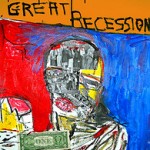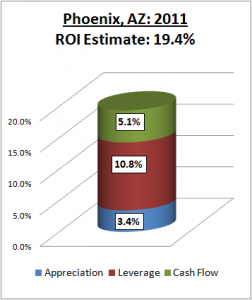 One of the important ratios to keep in mind when examining the equity markets is the gold price relative to the major stock market indexes. This provides a valuable insight into the extent to which market values reflect a real shift of sentiment toward equity value, versus the extent to which the value has lost value, driving increases in nominal valuations to simply retain purchasing power. Over the last 35 years, the relative price of Gold1 and the S&P 5002 has oscillated up and down very significantly. In the aftermath of 2008 and the financial crisis, this ratio has regressed toward a value of 1.0, which indicates equal valuation for the S&P 500 index and an ounce of gold. In the latter half of 2010, the S&P 500 vs. Gold ratio dropped below 1.0 as Gold prices were pushed up by speculators seeking to hedge against expected future inflation. Our analysis indicates that this trend is likely to continue through 2011 as monetary expansion inflates both asset classes.
One of the important ratios to keep in mind when examining the equity markets is the gold price relative to the major stock market indexes. This provides a valuable insight into the extent to which market values reflect a real shift of sentiment toward equity value, versus the extent to which the value has lost value, driving increases in nominal valuations to simply retain purchasing power. Over the last 35 years, the relative price of Gold1 and the S&P 5002 has oscillated up and down very significantly. In the aftermath of 2008 and the financial crisis, this ratio has regressed toward a value of 1.0, which indicates equal valuation for the S&P 500 index and an ounce of gold. In the latter half of 2010, the S&P 500 vs. Gold ratio dropped below 1.0 as Gold prices were pushed up by speculators seeking to hedge against expected future inflation. Our analysis indicates that this trend is likely to continue through 2011 as monetary expansion inflates both asset classes.
Year: 2011
Paying the Man
 The current financial situation in the United States is on the precipice of major interest rate increases that will be precipitated by one of two events. The basis for both scenarios is the profligate monetary expansion undertaken by the Federal Reserve over the last year to address a perceived risk of deflation and purchasing bonds from the Treasury to artificially hold down interest rates. This current trend of monetary expansion cannot be sustained indefinitely without consequence.
The current financial situation in the United States is on the precipice of major interest rate increases that will be precipitated by one of two events. The basis for both scenarios is the profligate monetary expansion undertaken by the Federal Reserve over the last year to address a perceived risk of deflation and purchasing bonds from the Treasury to artificially hold down interest rates. This current trend of monetary expansion cannot be sustained indefinitely without consequence.
Fiscally Fit: A Check-Up for Your Financial Fitness
 Fiscally Fit: A check-up for your financial fitness
Fiscally Fit: A check-up for your financial fitness
1. What happens to home values when the replacement costs increase?
a. The go up like a rocket
b. They go down because nobody can afford to build
c. They are pulled toward the cost of new construction
d. They don’t change . . . construction costs don’t matter
2. What is happening to the economy now that the debt bubble has burst?
a. The recovery going to happening, because Ben Bernake said so
b. The government attempting to re-inflate the debt bubble in order to stimulate short-term demand
c. It’s just like the great depression, only worse
d. The recovery has already started . . . the government reporting agencies are just suppressing the information
Here’s Where Interest Rates Are Going This Year
Denver Likely to Post 13.1% Profit in 2011
 The Denver area has been a historically stable real estate market for both owners and investors. Market values experienced a downward correction following the financial crisis of 2008, showed signs of stabilization as 2009 transpired, but that stabilization was short-lived, as the market experienced volatility moving out of 2009 and into 2010. Currently, approximately 35% of listings in Denver are foreclosures.
The Denver area has been a historically stable real estate market for both owners and investors. Market values experienced a downward correction following the financial crisis of 2008, showed signs of stabilization as 2009 transpired, but that stabilization was short-lived, as the market experienced volatility moving out of 2009 and into 2010. Currently, approximately 35% of listings in Denver are foreclosures.
Money Mischief
 By now, most people have heard about the second round of “Quantitative Easing” being conducted by the Federal Reserve. In short, this means that the Fed will be purchasing treasury bills with freshly printed money to inject more cash into the monetary system. To date, most of this additional liquidity has been limited to banks who have opted to hold the capital instead of loan it out. The reason for this is because the banks can borrow from the Fed at extremely low overnight interest rates and use the capital to purchase treasuries with a yield rate that exceeds their cost of borrowing.
By now, most people have heard about the second round of “Quantitative Easing” being conducted by the Federal Reserve. In short, this means that the Fed will be purchasing treasury bills with freshly printed money to inject more cash into the monetary system. To date, most of this additional liquidity has been limited to banks who have opted to hold the capital instead of loan it out. The reason for this is because the banks can borrow from the Fed at extremely low overnight interest rates and use the capital to purchase treasuries with a yield rate that exceeds their cost of borrowing.
Double-Dip Recession
 The recent financial news has been abuzz with exhortations over the anticipation of an end to the recent financial calamity. The stock market has already discounted this optimism into its valuation, as current market values represent a multiple of forecasted earnings per share well in excess of historical trends. The conventional wisdom is that the economy will get “back on track” in the next few months and resume its previous trajectory of long term growth. The factor that nobody seems to be considering is the fact that the previous ‘track’ the economy had been traveling down is the express route to collapse that generated this whole financial meltdown in the first place.
The recent financial news has been abuzz with exhortations over the anticipation of an end to the recent financial calamity. The stock market has already discounted this optimism into its valuation, as current market values represent a multiple of forecasted earnings per share well in excess of historical trends. The conventional wisdom is that the economy will get “back on track” in the next few months and resume its previous trajectory of long term growth. The factor that nobody seems to be considering is the fact that the previous ‘track’ the economy had been traveling down is the express route to collapse that generated this whole financial meltdown in the first place.
Keeping Housing Fair
 In 1968, the Fair Housing Act was adopted by congress, and amended in 1988 to increase the role of enforcement for the department of Housing and Urban Development (HUD). One of the most important points for fair housing enforcement is the fact that discrimination against protected classes is prohibited for home sales, rental housing, and mortgage lending. For the purposes of HUD, protected classes include race, color, national origin, religion, familial status, or handicap.
In 1968, the Fair Housing Act was adopted by congress, and amended in 1988 to increase the role of enforcement for the department of Housing and Urban Development (HUD). One of the most important points for fair housing enforcement is the fact that discrimination against protected classes is prohibited for home sales, rental housing, and mortgage lending. For the purposes of HUD, protected classes include race, color, national origin, religion, familial status, or handicap.
Re-Inflating the Debt Bubble
 Reading the news has never been the best way to inspire optimism. This phenomenon has never been more true than it is today for financially astute people that are aware of causes and consequences. In a recent press conference, the US President was touting a new blitz of government programs to get the US economy “back on track.” On the surface, this seems like a laudable goal, until you consider what is meant by getting the economy back on the track it was previously traveling.
Reading the news has never been the best way to inspire optimism. This phenomenon has never been more true than it is today for financially astute people that are aware of causes and consequences. In a recent press conference, the US President was touting a new blitz of government programs to get the US economy “back on track.” On the surface, this seems like a laudable goal, until you consider what is meant by getting the economy back on the track it was previously traveling.
Almost 20% Profit on Phoenix Properties Expected in 2011
 Market values in Phoenix are currently at approximately the same level as in the year 2000. The market area experienced a tremendous run-up during the real estate bubble and a spectacular during the financial crisis. During 2010, the regression back to fundamentals continued in Phoenix. For people who bought at the wrong time, this value contraction leverages out to a rather substantial loss. However, the current low interest rates allow buyers to generate cash flows that will help them to sustain the investment through value fluctuations until a path of growth is resumed.
Market values in Phoenix are currently at approximately the same level as in the year 2000. The market area experienced a tremendous run-up during the real estate bubble and a spectacular during the financial crisis. During 2010, the regression back to fundamentals continued in Phoenix. For people who bought at the wrong time, this value contraction leverages out to a rather substantial loss. However, the current low interest rates allow buyers to generate cash flows that will help them to sustain the investment through value fluctuations until a path of growth is resumed.

